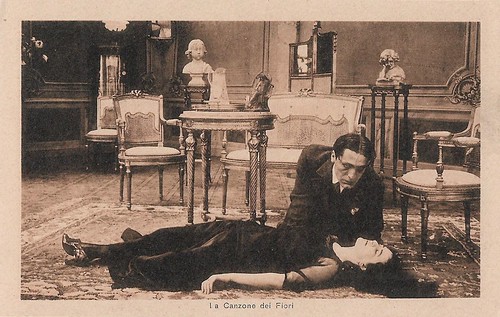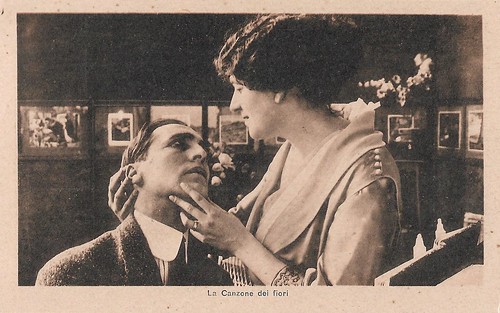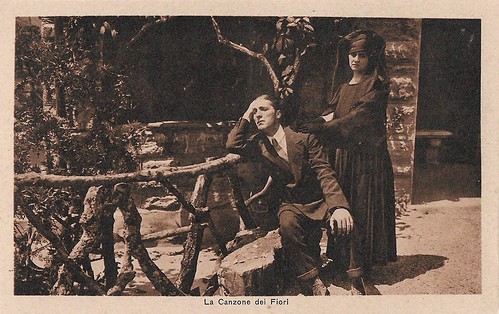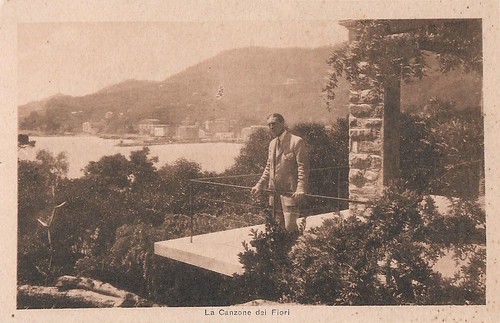
Envelope of series of 15 postcards for Giudice e padre (Gian Giorgio Trissino, 1917) by Topografia Roberto Conti, Terni. Production company of the film was La Dominante, Venice.

Italian postcard by Topografia Roberto Conti, Terni, no. 5723, card 1 of a series of 15. Photo: La Dominante, Venice. Publicity still for Giudice e padre (Gian Giorgio Trissino, 1917). Caption: La canzone dei fiori (The Song of the Flowers).

Italian postcard by Topografia Roberto Conti, Terni, no. 5724, card 2 of a series of 15. Photo: La Dominante, Venice. Publicity still for Giudice e padre (Gian Giorgio Trissino, 1917). Caption: La canzone dei fiori (The Song of the Flowers).

Italian postcard by Topografia Roberto Conti, Terni, no. 5725, card 3 of a series of 15. Photo: La Dominante, Venice. Publicity still for Giudice e padre (Gian Giorgio Trissino, 1917). Caption: La canzone dei fiori (The Song of the Flowers).

Italian postcard by Topografia Roberto Conti, Terni, no. 5726, card 4 of a series of 15. Photo: La Dominante, Venice. Publicity still for Giudice e padre (Gian Giorgio Trissino, 1917). Caption: La canzone dei fiori (The Song of the Flowers).

Italian postcard by Topografia Roberto Conti, Terni, no. 5727, card 5 of a series of 15. Photo: La Dominante, Venice. Publicity still for Giudice e padre (Gian Giorgio Trissino, 1917). Caption: La canzone dei fiori (The Song of the Flowers).

Italian postcard by Topografia Roberto Conti, Terni, no. 5728, card 6 of a series of 15. Photo: La Dominante, Venice. Publicity still for Giudice e padre (Gian Giorgio Trissino, 1917). Caption: La canzone dei fiori (The Song of the Flowers).

Italian postcard by Topografia Roberto Conti, Terni, no. 5729, card 7 of a series of 15. Photo: La Dominante, Venice. Publicity still for Giudice e padre (Gian Giorgio Trissino, 1917). Caption: La canzone dei fiori (The Song of the Flowers).
Did he kill her? Did she commit suicide?
Yes, Giudice e padre/Judge and Father is a bit of a mystery to us. We couldn't find a real plot description of the film. The postcard series suggests that the film starts with the son of a judge confronted with a young dead woman (did he kill her? did she commit suicide?). He is clearly vexed and so are his parents, as his father will have to judge his son. The continuation of the story may be one big flashback, but it could also be that the young man starts a new affair with another young woman. Anyway, he seems to reconcile with his father and ends up in a convent.
While the indoor sets look well-dressed and some outdoor shooting must have been done at the Italian lakes and perhaps the Po delta (the duck hunting), the performance seems at times quite histrionic and over the top, in particular by the son, played by Guido Guiducci, and the father, played by Pier Camillo Tovagliari. The cinematography was by Ottorino Tedeschini. Other actors in the cast were Gemma Albini, Annunziata Mazzini, and Giuseppe Farnesi. The postcards were approved by a censor at Terni on 25 August 1917 and the film was released in Italy in November 1917.
Guido Guiducci (?-?) was an Italian silent film actor between 1914 and 1923. He started out at Firenze Film in films by Carla Cattaneo and Salvo Alberto Salvini. His career really set off at Vera Film in films by Aldo Molinari such as Un duello nell'ombra/A Duel in the Shadows (1916), Saffo/Sappho (1918) and Giuditta e Oloferne/Judith and Holofernes (1920) starring Ileana Leonidoff. At Tiber Film, he starred in such films as Come le foglie/Like the Leaves (Gennaro Righelli, 1917) and La fibra del dolore/The fibre of pain (Baldassarre Negroni, 1919).
Guiducci followed director Baldasarre Negroni and his star and wife Hesperia to Film d'Arte Italiana where he appeared in La signora senza pace/The Restless Lady (Baldasarre Negroni, 1919), and Bimbi lontani/Distant children (Baldasarre Negroni, 1919). Guiducci also worked at Floreal in Il pastor fido/The faithful shepherd (Telemaco Ruggeri, 1918), La mano tagliata/The severed hand (Alberto Degli Abbati, 1919), and Ti voglio... bene!/I love... you! (Alberto Degli Abbati, 1919), in each film opposite Mary Bayma-Riva.
In 1920 Guiducci acted at Politica-Film in Un'alba/A dawn (Eugenio Fontana, 1920), based on a play by V.I. Lenin, the founder of the Russian Communist Party, but he also starred as Moses in one of his last films, La Sacra Bibbia (Pier Antonio Gariazzo, 1920), produced by the Milanese producer Armando Vay (or Armando Vey). The Old Testament spectacle was touted as a "$3,000,000 Entertainment for the Hundred Millions, from the creation of Adam and Eve to the parting of the Red Sea." The advertising claimed it was filmed over a period of five years at the "Exact Locations of Biblical History." Thge film was split either into three separate films: La Sacra Bibbia (on Genesis), Joseph, and Moses, or in five parts, going from Adam and Eve to Ruth. The film must indeed have been a big undertaking, with loads of extras and animals, but we think, its claim that all exteriors were shot on location needs to be taken with a pinch of salt.
The press within and outside of Italy was quite critical of the film and thought it too vulgar, ahistorical, and clumsy, including a visibly too young actor - Guiducci - for the role of Moses, and a simplistic splitting of the Red Sea. Of course, just a few years after, Cecil B. DeMille would dwarf Gariazzo's project by his own epic, The Ten Commandments (Cecil B. DeMille, 1923), with its giant real sets and ingenious special effects. It's hard to judge La Sacra Bibbia now for oneself. Today, only a heavily cut-back edition from 1929 is what remains of the film. On the other hand, Aldo Molinari thought the film good enough to use parts of it for his epic Giuditta e Oloferne (1920) with Ileana Leonidoff as Judith.
After one more Mary Bayma-Riva vehicle, La storia di una cigaretta/The story of a cigarette (Mario Volpe, 1921), Guido Guiducci closed off his career with a film directed by himself: Occhi lucenti/Bright eyes (Guido Guiducci, 1923) for Fiorenza Film. We could not find more information about him.

Italian postcard by Topografia Roberto Conti, Terni, no. 5730, card 8 of a series of 15. Photo: La Dominante, Venice. Publicity still for Giudice e padre (Gian Giorgio Trissino, 1917). Caption: La canzone dei fiori (The Song of the Flowers).

Italian postcard by Topografia Roberto Conti, Terni, no. 5731, card 9 of a series of 15. Photo: La Dominante, Venice. Publicity still for Giudice e padre (Gian Giorgio Trissino, 1917). Caption: La canzone dei fiori (The Song of the Flowers).

Italian postcard by Topografia Roberto Conti, Terni, no. 5732, card 10 of a series of 15. Photo: La Dominante, Venice. Publicity still for Giudice e padre (Gian Giorgio Trissino, 1917). Caption: La canzone dei fiori (The Song of the Flowers).

Italian postcard by Topografia Roberto Conti, Terni, no. 5733, card 11 of a series of 15. Photo: La Dominante, Venice. Publicity still for Giudice e padre (Gian Giorgio Trissino, 1917). Caption: La canzone dei fiori (The Song of the Flowers).

Italian postcard by Topografia Roberto Conti, Terni, no. 5734, card 12 of a series of 15. Photo: La Dominante, Venice. Publicity still for Giudice e padre (Gian Giorgio Trissino, 1917). Caption: La canzone dei fiori (The Song of the Flowers).

Italian postcard by Topografia Roberto Conti, Terni, no. 5735, card 13 of a series of 15. Photo: La Dominante, Venice. Publicity still for Giudice e padre (Gian Giorgio Trissino, 1917). Caption: La canzone dei fiori (The Song of the Flowers).

Italian postcard by Topografia Roberto Conti, Terni, no. 5736, card 14 of a series of 15. Photo: La Dominante, Venice. Publicity still for Giudice e padre (Gian Giorgio Trissino, 1917). Caption: La canzone dei fiori (The Song of the Flowers).

Italian postcard by Topografia Roberto Conti, Terni, no. 5737, card 15 of a series of 15. Photo: La Dominante, Venice. Publicity still for Giudice e padre (Gian Giorgio Trissino, 1917). Caption: La canzone dei fiori (The Song of the Flowers).
Sources: Vittorio Martinelli (Il cinema muto italiano), and IMDb.
No comments:
Post a Comment